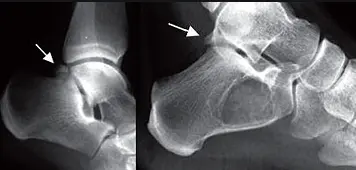Sports Injuries and Management
Os Trigonum Syndrome A Ballet Dancers Nightmare
Ankle Pain And Posterior Tibial Talar Impingement Syndrome
Several different terminologies have been used to describe the condition termed Os Trigonum Syndrome. Os Trigonum Syndrome is characterised by pain felt in the back of the ankle, elicited with toe pointing (plantarflexion) motions. Sometimes also referred to as the symptomatic os trigonum, talar compression syndrome, posterior tibial talar impingement syndrome, posterior ankle impingement, talar compression syndrome and posterior ankle block is a painful condition that can limit both sporting and daily function.
As an “injury” it can be the result of either a single traumatic event, or present as an overuse injury resulting from the repetitive microtrauma of repetitive forced plantar flexion stress. Os Trigonum Syndrome as a condition is not uncommon in ballet dancers and soccer players due to the necessity and frequency of forced plantarflexion actions in these sports. Examples being in ballet the specific action of dancing on pointe places the ankle in forced plantarflexion and in football striking a football with the laces of the boot through a pointed foot equally forces the ankle into full plantarflexion and can cause and/or exacerbate pain in the back of the ankle. With Os Trigonum Syndrome these described movements in ballet and football cause posterior ankle pain through the entrapment of an accessory bony ossicle between the talus and calcaneus (your heel bone) as the ankle is forced into plantarflexion as can be visualised by the arrow in the X-ray images below.
Anatomy: What Is The Os Trigonum?
The os trigonum is a small, round, oval or triangular piece of bone with smooth or serrated margins of varied size. Typically an os trigonum is less than 1cm circumference and is located in the back of the ankle joint again as seen by the arrow in the image above. The posterior talar process usually fuses with the rest of the body of the talus bone by early teenage years in individuals with an os trigonum this part of the talus forms as a separate bony ossicle. Reports vary, but it is suggested that somewhere around 5-20% of people during growth develop a os trigonum as the posterior talar process fails to fully fuse with the rest of the talus resulting in this separate bony ossicle and is connected to the rest of the ankle through fibrous or cartilaginous tissue. Impingement of the os trigonum through forced plantaflexion may cause irritation to the bony ossicle itself or this associated fibrous or cartilaginous tissue.
At Sydney Physio Clinic we are happy to assess all range of ankle injuries including providing advice and treatment for any diagnosed Os Trigonum Syndrome.
Disclaimer: Sydney Physio Clinic does not endorse any treatments, procedures, products mentioned. This information is provided as an educational service and is not intended to serve as medical advice. Anyone seeking specific advice or assistance regarding Os Trigonum Syndrome A Ballet Dancers Nightmare should consult his or her general practitioner, sports medicine doctor or physiotherapist.



